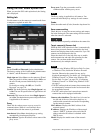
Others
Glossary
125
Primary DNS server
One of the DNS servers that can first reply to a request
by connected devices or other DNS servers.
Proxy server
A server or software that acts as an intermediary
between a local network and the Internet so that it can
connect to the Internet in place of a computer on a local
network.
PSK
Abbreviation for Pre-Shared Key. This is a shared key to
make an encryption key, used with TKIP in WPA
encryption standard. PSK sometimes means an
authentication system using a key previously shared.
QoS
Enter a value in the DSCP (Differential Service Code
Point) field included in the IP header to control
communication service quality.
RADIUS client
RADIUS (Remote Authentication Dial-in User Service)
is an authentication and accounting protocol managing
network access, and a RADIUS client is a party that
accesses the network.
In Internet connecting service, a Network Access Server
(NAS) such as that for dial-up and broadband access
server is a RADIUS client. In a wireless LAN system, a
wireless LAN access point is a RADIUS client.
Saturation
The degree to which a color is pure.
Secondary DNS Server
Subsidiary DNS server used when a primary DNS server
cannot be used.
Shared secret
A character string to be used for mutual authentication
between a RADIUS server and RADIUS client.
Sharpness
The degree to which the boundary of two portions is
clearly distinguished.
SMTP server
A server for sending or relaying e-mail messages
between servers.
SNMP
A protocol for monitoring and managing network
devices.
SSL
Acronym for Secure Sockets Layer. This is a protocol
developed by Netscape Communications Corporation to
be used for communications of encrypted data on the
Internet.
Subnet mask
32-bit stream used to distinguish the subnet address
from an IP address.
TCP
Acronym for Transmission Control Protocol. A standard
protocol used for Internet connection. Compared with
the other protocol, UDP, TCP provides reliable
communication but communication speed is slower.
TKIP
Acronym for Temporal Key Integrity Protocol. This is
used in WPA encryption for a wireless LAN. TKIP
provides high security since it changes encryption keys
based on PSK during on-going communication.
UDP
Acronym for User Datagram Protocol. A standard
protocol used for Internet connection. Compared with
the other protocol, TCP, UDP can transmit data faster,
but reliable communication is not guaranteed.
Unicast
Transmission of data to specified equipment on a
network by specifying a single address.
WPA
Acronym for Wi-Fi Protected Access. This is an
encryption standard for a wireless LAN. It provides
higher security than the conventional WEP (Wired
Equivalent Privacy) standard. In WPA, TKIP is used for
the encryption method, and PSK and EAP are used for
the authentication protocol.
WPA2
Abbreviation for Wi-Fi Protected Access 2. WPA2 is a
standard with which AES (Advanced Encryption
Standard) is added to WPA.
802.1X
A standard that performs user authentication and
dynamic key generation and traffic on a LAN.


















